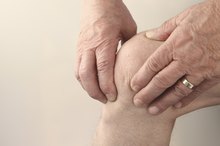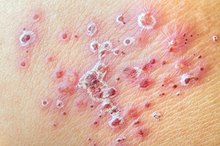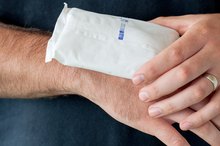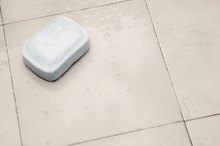What does fact checked mean?
At Healthfully, we strive to deliver objective content that is accurate and up-to-date. Our team periodically reviews articles in order to ensure content quality. The sources cited below consist of evidence from peer-reviewed journals, prominent medical organizations, academic associations, and government data.
The information contained on this site is for informational purposes only, and should not be used as a substitute for the advice of a professional health care provider. Please check with the appropriate physician regarding health questions and concerns. Although we strive to deliver accurate and up-to-date information, no guarantee to that effect is made.
Ice Effects on Shingles
Shingles is the common name for the disease that results from reactivation of the varicella-zoster virus--the same virus that causes chicken pox upon initial exposure--within the roots of spinal or cranial nerves. According to National Institutes of Health dermatologist Stephen E. Straus in the 2008 edition of “Fitzpatrick’s Dermatology in General Medicine,” shingles produces a blistering skin rash, often accompanied by severe burning, stabbing, throbbing or electrical pain 2. While ice can provide temporary relief from shingles pain, prolonged use can lead to local tissue damage.
If you are experiencing serious medical symptoms, seek emergency treatment immediately.
Mechanism of Action
In the 2009 edition of “Hazzard’s Geriatric Medicine and Gerontology,” University of Alabama Professor Cynthia J 1. Brown, M.D., M.S.P.H. explains that cold results in constriction of the blood vessels of the skin, decreased nerve conduction velocity, decreased muscle spasms and short-term pain relief. With prolonged application, blood vessel constriction leads to tissue damage due to a shortage of nutrients and oxygen. Patients can’t detect that this is happening because cold quells the pain that would normally accompany inadequate blood flow.
- In the 2009 edition of “Hazzard’s Geriatric Medicine and Gerontology,” University of Alabama Professor Cynthia J 1.
- Patients can’t detect that this is happening because cold quells the pain that would normally accompany inadequate blood flow.
Application
Knee Pain From Shingles
Learn More
In the 2009 edition of “Hazzard’s Geriatric Medicine and Gerontology,” National Institute of Aging researcher Shari M. Ling, M.D 1. describes the safe application of ice to skin affected by pain. According to Ling, patients should limit application to no more than 20 minutes per session, or when skin becomes numb. Patients who experience pain when ice is removed should apply heat immediately because pain is a sign of tissue damage.
Alternatives
As alternatives to ice, says Brown, patients can use cold packs, cold water immersion, cooling massage and vapocoolant sprays. In the January 2008 edition of “Knee Surgery,” Medical University of South Carolina orthopedic surgeon Shane K. Woolf describes a device called a “CryoCuff” that provides continuous, temperature-controlled cold therapy. According to Woolf, patients who used the device for pain due to outpatient knee surgery reported significantly superior pain relief compared to patients who used traditional ice packs.
Complications
Ice Pack Dangers
Learn More
Ice causes tissue damage when water and fats within skin freeze. In the 2008 edition of “Fitzpatrick’s Dermatology in General Medicine,” dermatologist Gerald E. Pierard describes the symptoms of cold-induced tissue damage: Superficial frostbite leads to pain, followed by blistering 24 to 36 hours later 2. White or blue skin and the absence of pain often signals deep frostbite. Deep frostbite blisters are typically more extensive than with superficial frostbite. When blister fluid resorbs, says Pierard, it leaves behind hard, black gangrenous tissue that must be removed surgically.
- Ice causes tissue damage when water and fats within skin freeze.
- In the 2008 edition of “Fitzpatrick’s Dermatology in General Medicine,” dermatologist Gerald E. Pierard describes the symptoms of cold-induced tissue damage: Superficial frostbite leads to pain, followed by blistering 24 to 36 hours later 2.
Contraindications
According to Brown, people with vascular disease, nerve injuries, a history of hypersensitivity to cold or a condition known as Raynaud’s disease should not use ice for shingles or any other condition. These people can develop injuries much more quickly than people without such conditions, and they may not be able to detect when injury has occurred.
Related Articles
References
- “Hazzard’s Geriatric Medicine and Gerontology, 6th Edition”; J.B. Halter et al.; 2009
- "Fitzpatrick's Dermatology in General Medicine, 7th Edition"; K. Wolff et al.; 2008
- "Journal of Knee Surgery"; Comparison of a Continuous Cryotherapy Device to a Simple Icing Regimen; S.K. Woolf et al.; 2008
- National Institute of Neurological Disorders and Stroke: Shingles: Hope Through Research
Writer Bio
Heather Gloria began writing professionally in 1990. Her work has appeared in several professional and peer-reviewed publications including "Nutrition in Clinical Practice." Gloria earned both a Bachelor of Science in food science and human nutrition from the University of Illinois. She also maintains the "registered dietitian" credential and her professional interests include therapeutic nutrition, preventive medicine and women's health.









